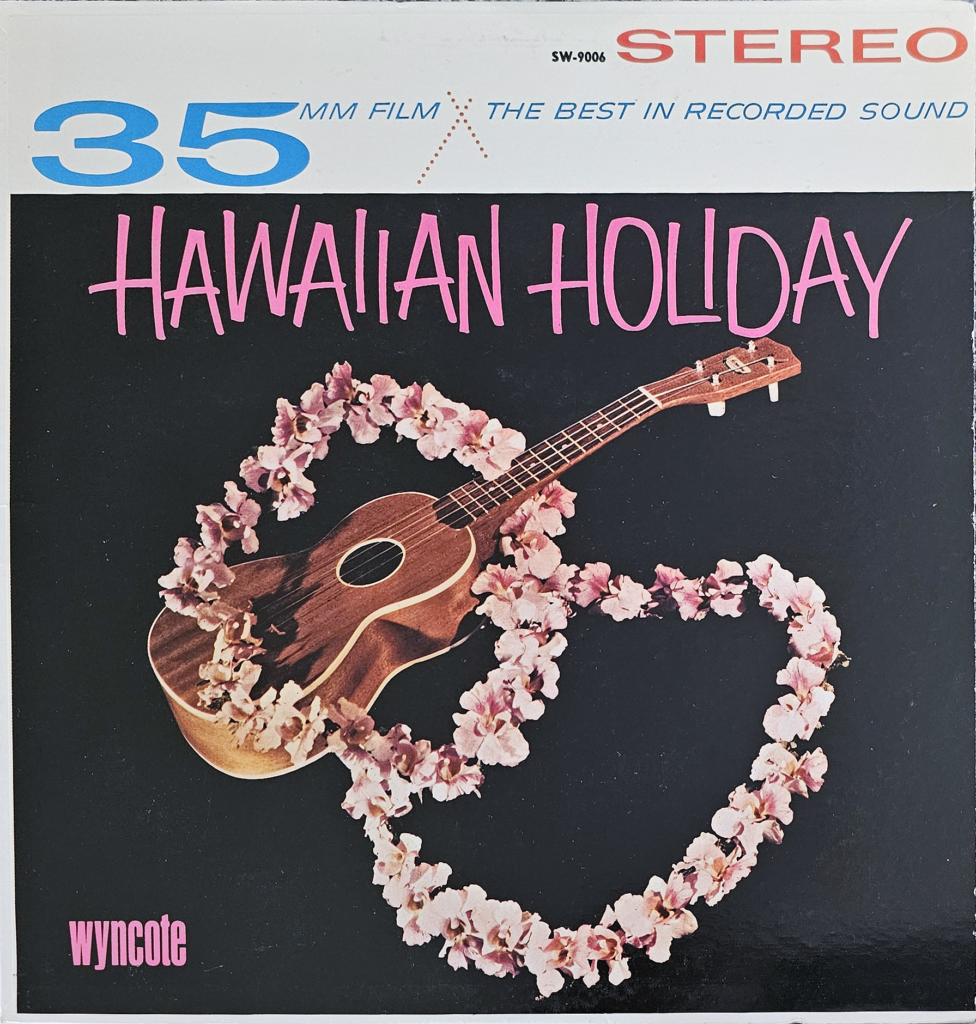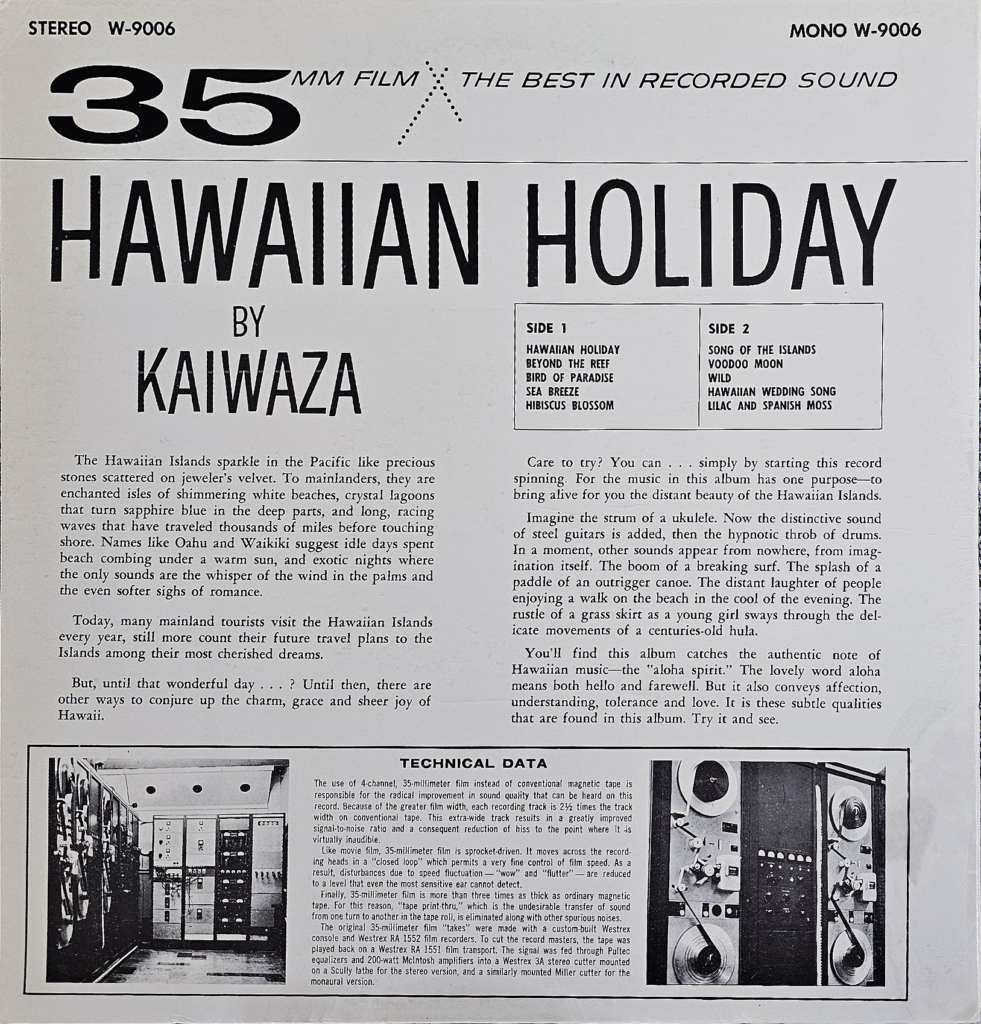Hello, fellow sound seekers! Welcome aboard Finnley’s submarine of sonic curiosities, where each echo leads to discovery, and every wave sings a story. I’m Finnley the Dolphin, your navigator on this voyage through the melodies of yesteryears and the whispers of audio innovation. Today, we’re setting the compass for a retro rendezvous, diving back into the golden sands of the 1960s to unearth an auditory gem that has bobbed up from the depths – the enchanting album “Hawaiian Holiday” by Kaiwaza.
In the boundless sea of Finnley’s Audio Adventures, our journey often takes us to the heart of sound itself, to places where music doesn’t just speak but resonates, carrying the marks of its era. “Hawaiian Holiday” emerges as a beacon in these waters, an album celebrated not merely for its tranquil tunes and the promise of paradise but for its revolutionary approach to sound. As we sail through the technical marvels and cultural waves that this album rides on, be prepared to dive deep into the world of pioneering recording techniques that reshaped the landscape of music production. So, strap on your snorkels, dear explorers, as we submerge into the story behind “Hawaiian Holiday,” viewed through the periscope of Finnley’s Audio Adventures. Here, history harmonizes with innovation, and the echoes of the past meet the ripples of the future. Get ready to plunge into the heart of this sonic oddity and surf the vibrant currents of a bygone era.

Nestled among the relics of a quaint thrift store, between whispers of the past and echoes of forgotten times, “Hawaiian Holiday” by Kaiwaza waits like a hidden pearl. Released by Wyncote Records in April 1964, this album is more than just a collection of melodies; it’s an invitation to the serene and picturesque landscapes of Hawaii, ah my former home, and the Pacific Islands, a tribute to the exotica genre that defined a decade. Yet, the true allure of “Hawaiian Holiday” lies beneath its surface, in the groundbreaking technology it heralded – the revolutionary use of “35mm Film – The Best in Recorded Sound.” This innovative technique offered an auditory experience unlike any other, turning this record into a monumental artifact of sound engineering.

The record sleeve of “Hawaiian Holiday” elaborately outlines the album’s technological advancements, welcoming audiences to experience superior sound quality. Shifting from standard magnetic tape to the innovative 4-channel, 35mm film technique, the album demonstrates a notable advancement in the realm of audio fidelity. This approach, adapted from film industry standards, utilizes a greater surface for recording, enabling the tracks to be 2½ times wider than those on conventional tape. This broader track width notably improves the signal-to-noise ratio, dramatically minimizing the usual background noise to nearly imperceptible levels, offering a clear departure from the typical audio imperfections of the time.
The use of sprocket-driven, 35-millimeter magnetic film (35mm film) ensured a consistent and controlled movement across the recording heads, establishing a closed loop that dramatically reduced any speed irregularities known as “wow” and “flutter.” This careful focus on maintaining consistent speed led to a level of clarity and fluidity in playback that had not been achieved before, bringing out the detailed richness and fine details of Hawaiian music were captured with unprecedented fidelity. Moreover, the thickness of the 35-millimeter film played a crucial role in combating the common issue of “tape print-thru” – the unintended transfer of sound from one layer of tape to another. This innovation ensured that each note and harmony on “Hawaiian Holiday” was preserved in its purest form, free from the common artifacts that plagued recordings of lesser quality.
The innovative approach in “Hawaiian Holiday” was not an isolated effort by Wyncote Records but a part of a larger strategy to enhance their collection with unmatched audio quality. This mission covered a range of musical types and styles, from the enchanting strings of “Romantic Spain” performed by The Carlos Zapater Orchestra to the dynamic rhythms of “Let’s Polka” by John Koleski and his Orchestra, benefits from the exceptional sound clarity achieved through 35-millimeter film recording, enhancing the quality of each album. The record company’s investment in this cutting-edge technology was also applied to the grand organ music in “The Organ Of Philadelphia” by William Whitehead, the vibrant tunes of “It’s Halftime U.S.A.” by The International Collegiates, and the serene melodies of “Hawaiian Paradise” by The Hawaiian Islanders. Each venture emphasized Wyncote’s pledge to deliver an unparalleled sound experience to its audience, thereby raising the bar for economical records.
The practice of employing 35mm magnetic film in recording was distinctively adopted by select industry players, significantly improving the quality and authenticity of their music productions. Among them, Everest Records stood out for its high-fidelity recordings, largely the work of engineer Bert Whyte using 35mm magnetic film. The label collaborated with esteemed conductors and orchestras like Sir Adrian Boult and Leopold Stokowski, striving for authentic sound capture by minimizing microphone usage. Everest aimed for a blend of technical excellence and musical depth, achieving monumental outcomes such as the first recording of Ralph Vaughan Williams’s Symphony No. 9.
Following Everest, the recording facilities and equipment were taken over by C. Robert Fine, who then applied the 35mm technology to Mercury’s “Living Presence” series. Moreover, Enoch Light, inspired by a performance by William Steinberg and the Pittsburgh Symphony Orchestra, engaged Steinberg and Fine for Command Classics, producing recordings celebrated for their clarity and wide dynamic range using the same technology.
Command Records, established by Enoch Light, was yet another innovator in the adoption of 35mm magnetic film for its recordings. Renowned for albums like “Provocative Percussion” and “Persuasive Percussion,” the label combined eye-catching modern artwork with superior sound quality. Following Command’s sale, Light founded Project 3, maintaining his dedication to high-fidelity sound while shifting focus towards the musical content rather than stereo effects.
The engagement with 35mm magnetic film by these entities marked their commitment to the highest sound quality standards, establishing new benchmarks in the recording industry and leaving a significant legacy appreciated by audiophiles and music enthusiasts alike.
Although it was renowned for its exceptional sound quality, the recording method using 35mm magnetic film gradually became obsolete in the mainstream sector. This decline was attributed to the expensive nature of both the film and the associated recording devices, as well as enhancements in conventional tape technology, which collectively decreased its popularity. Nonetheless, the vintage equipment and recordings turned into highly prized artifacts, cherished by both audiophiles and collectors alike. In recent years, this format has experienced a revival, thanks to new remastering techniques that have revitalized these old 35mm recordings, allowing contemporary audiences to immerse themselves in the rich, intricate soundscapes that were originally produced many years ago. By the mid-1960s, this technique had dwindled, primarily due to the advances in tape machinery and tape compositions, along with the prohibitive costs related to handling 35mm magnetic film, rendering the method impractical for widespread application. Nevertheless, the original recording equipment was preserved and subsequently employed in the Mercury Living Presence CD remasters. The original Everest 35mm recordings have also been rejuvenated through high-definition digital remastering.
While the era of 35mm magnetic film recording was brief, its impact on the music industry and audio recording technology was profound. It set a new standard for sound quality, pushing the boundaries of what was possible and inspiring future innovations. The albums produced during this golden era, such as “Hawaiian Holiday,” remain timeless artifacts of a period when sound was as expansive as the ocean itself.
In the vibrant music scene of the 1960s, Bernie Lowe, born Bernard Lowenthal, founded Cameo Records in Philadelphia in 1956. This initiative quickly expanded, merging with Parkway Records in 1958 to form Cameo-Parkway Records, marking the birth of a significant force in the American music industry. The new label became a hub for a variety of music styles including doo-wop, rock, rockabilly, big band, garage rock, soul, and novelty records. It was instrumental in launching the careers of notable artists like Bobby Rydell, Chubby Checker, Charlie Gracie, Dee Dee Sharp, The Orlons, The Dovells, and The Tymes. Rydell and Checker, in particular, became emblematic of the era, with Checker’s “The Twist” igniting a nationwide dance craze.
Despite this success, the early 1960s brought challenges. The British Invasion, led by bands like The Beatles, altered American musical tastes. Additionally, the relocation of “American Bandstand” from Philadelphia to Los Angeles diminished a crucial platform for national exposure. These factors, combined with internal struggles, led to a decline in the label’s influence and financial health. Disheartened, Bernie Lowe departed from the company in 1964 amidst these tumultuous changes.
In the wake of Lowe’s exit, Cameo-Parkway sought new avenues for success. This led to the establishment of Wyncote Records in 1964 as a subsidiary to reissue the large back catalog of Cameo-Parkway and introduce budget-friendly compilation albums. Named after a Philadelphia suburb, Wyncote aimed to make music more accessible, specializing in compilations from existing Cameo and Parkway artists, along with new albums covering film soundtracks and easy listening genres. Distributed mainly in drugstores, bookstores, and department stores, Wyncote’s offerings reflected the budget label ethos of the 1960s, balancing cost with a burgeoning demand for music.
Wyncote Records explored various musical styles, issuing albums like “Java” by Jim Collier and “Theme Music from ‘The Carpetbaggers'” by the Wyncote Orchestra & Chorus. Their catalog spanned country, jazz, Latin, and popular hits from musicals like “Hello, Dolly!” and “Funny Girl.” They even tapped into the dance craze with records such as “Let’s Polka” and “Dancin’ Hits,” featuring artists like Chubby Checker and The Orlons. Their strategy focused on popular music renditions by emerging artists, presenting an affordable alternative to mainstream records without sacrificing the innovative edge, particularly in recording technologies.
However, the shifting musical landscape and internal changes continued to challenge both Cameo-Parkway and its offspring, Wyncote. The dominance of other labels, such as Motown, and evolving consumer tastes further strained their positions. By 1967, the compounded financial pressures and changing industry dynamics led to the sale of Cameo-Parkway, marking the end of an era. Wyncote Records ceased operations as part of this transition, but its legacy persisted, embodied in albums like “Hawaiian Holiday.” These records stand as testaments to a bygone era, reflecting the blend of musical creativity and technological innovation of the time.
Despite their eventual decline, the impact of Cameo-Parkway and Wyncote Records on the music industry and the development of the Philadelphia Sound remains significant. Their contributions, especially in promoting the dance craze era and nurturing early rock and roll and soul music, continue to resonate. The legacies of these labels are cherished by collectors and music enthusiasts alike, preserving a unique chapter in the history of American music.
And just like that, we find ourselves surfacing from the deep dive into the colorful world of “Hawaiian Holiday” and the innovative spirit of Wyncote Records. It’s been a journey where the warm, island breezes met the cold, hard edge of technology, creating a blend of sounds as intriguing as the ocean’s own mysteries. In the vast sea of music history, Wyncote’s foray into 35mm film recording may appear as just a drop in the ocean, but, fellow finned friends, it’s a drop that ripples, influencing sound quality and recording techniques in ways that continue to echo. This adventure has not only showcased the charming anomalies of an era gone by but also underscored the timeless quest for audio excellence.
So, as we bid adieu to the tropical tunes of Kaiwaza and the technical triumphs of the 1960s, I encourage all of you in my pod of peculiar sound seekers to stay tuned. The ocean of audio oddities is vast and full of surprises, and here at Finnley’s Audio Adventures, we’re just getting started. Remember, every wave brings a new sound, every tide reveals a new tale. Catch you on the next wave of Finnley’s Audio Adventures – where every listen is an adventure! Until then, keep swimming through the symphony of life, keep your sonar tuned to the frequencies of fun, and, above all, let the currents of curiosity carry you forward.
Sources:
IEEE Xplore-
https://ieeexplore.ieee.org/stamp/stamp.jsp?arnumber=7254681
https://ieeexplore.ieee.org/stamp/stamp.jsp?arnumber=7258088
musiceureka-
World Radio History-
Vinyl Philly-
https://vinylphilly.squarepins.org/
Both Sides Now Publications-
https://www.bsnpubs.com/philadelphia/cameo/camparkstory.html
